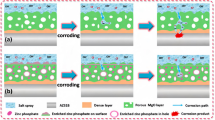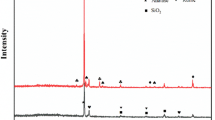Conclusions
It has been established that the erosion rate of P/M Ag-Ni composite contacts between which arc discharges of 25-A current amplitude are excited is related to their composition. It is shown that materials with a nickel content of 50–75% possess adequate erosion resistance, and are not inferior in this respect to the industrial SN-30 and SN-40 alloys (sintered Ag-30% Ni and Ag-40% Ni materials). It has been found that the erosion of Ag-Ni composite anodes depends on the thermophysical properties of cathodes made of metals or composites of various kinds. It is demonstrated that certain characteristic features of Δm vs composition curves can be satisfactorily explained in the light of the theory postulating that an arc discharge “locks” itself to the least conducting phase and of the relationship between the energetic parameters of jets of eroded mass and and the thermophysical properties of electrodes. The study has also revealed that dissimilar pairs composed of Ag cathodes and Ag-Ni anodes containing up to 60% of nickel are comparable in wear resistance to pure silver contacts; use of such pairs, after they have proved their merits in practical tests, will result in a significant saving in silver consumption.
Similar content being viewed by others
Literature cited
A. B. Al'tman, I. P. Melashenko, and É. S. Bystrova, “Modern sintered contacts,” Transactions of a Conference on Electrical Contacts [in Russian], Gosenergoizdat, Moscow-Leningrad (1958), pp. 171–186.
H. H. Kocher and D. Stöckel, “Material transfer of composite contact materials,” IEEE Trans. Components Hybrids Manuf. Technol.,2, No. 1, 15–19 (1979).
I. P. Melashenko, Electrical Switch Contacts and Materials for Them [in Russian], Informélektro, Moscow (1976).
I. I. Beilis, G. N. Braterskaya, V. I. Rakhovskii, and O. K. Teodorovich, “Investigation of the erosion of sintered silver-nickel contacts in light-current circuits,” Transactions of a Conference on Electrical Contacts [in Russian], Énergiya, Moscow (1967), pp. 179–187.
N. L. Pravoverov, “Locking of an arc discharge to the surface of a two-component fiber electrode,” Elektrotekh. Prom., Ser. Apparaty Nizkogo Napryazheniya, No. 6, 1–2 (1979).
Recommended Procedures. Electrical Contact Components: Methods for Erosion Resistance Testing under Electric Arc Conditions [in Russian], Standartov, Moscow (1977).
N. N. Afanas'ev, “Erosion resistance of contact materials,” in: Electrical Contacts [in Russian], Gosénergoizdat, Moscow (1958), pp. 50–63.
Author information
Authors and Affiliations
Additional information
Translated from Poroshkovaya Metallurgiya, No. 6(234), pp. 61–66, June, 1982.
Rights and permissions
About this article
Cite this article
Pravoverov, N.L., Duksina, A.G. & Duksin, Y.I. Electrical erosion of P/M composites of the silver-nickel system. Powder Metall Met Ceram 21, 475–479 (1982). https://doi.org/10.1007/BF00801759
Received:
Issue Date:
DOI: https://doi.org/10.1007/BF00801759




